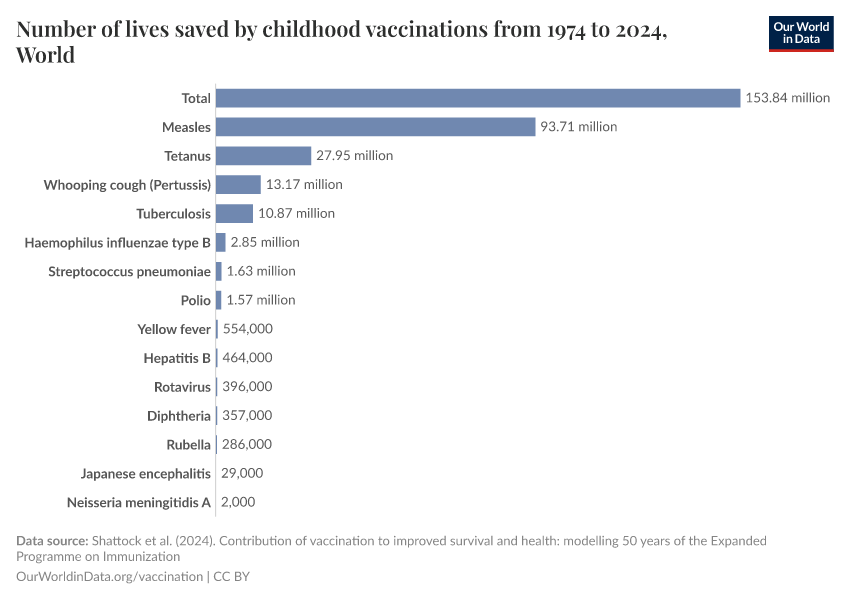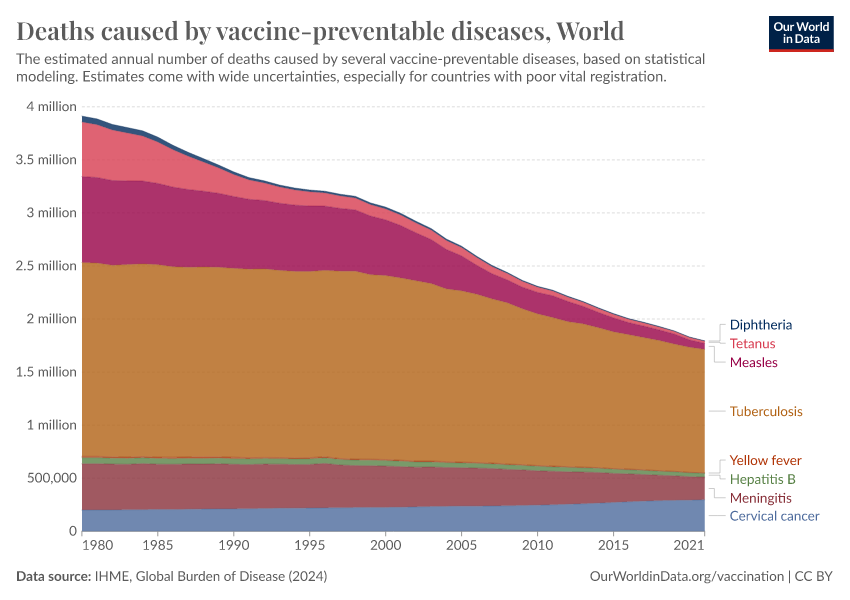Vaccines have saved 150 million children over the last 50 years
Every ten seconds, one child is saved by a vaccine against a fatal disease.
By the time you finish reading this, around 30 children will have been saved thanks to vaccines.1
Over the last 50 years, that adds up to 150 million children.2 That’s more than twice the population of the United Kingdom.
That’s 150 million children who will grow up, experience life, and contribute to the world; over a hundred million sets of parents who were spared the tragedy of having to bury their children.
This figure comes from a new study from Andrew Shattock and other researchers from around the world. They estimated the number of lives saved from vaccinations against different diseases over the past 50 years.3
The two charts below show the number of lives saved, broken down by disease and region.
Vaccination against measles has had the biggest impact, saving 94 million lives over the last 50 years — more than 60% of the total.4

This has been a truly global effort, with more than 5 million children saved in every region, including over 50 million in Africa and 38 million in Southeast Asia. You can see the cumulative number of lives saved by WHO region in the chart below.

Vaccination has been a massive driver of reductions in infant mortality
Children of all ages have benefited massively from the expansion of immunization programs. But it’s in infants that vaccines have had the most crucial impact.
Infant mortality rates have plummeted over the last 50 years.
Globally, they’ve fallen by over two-thirds, from around 10% in 1974 to less than 3% today.
The study’s researchers estimate vaccinations have reduced infant mortality by 40%.
The rest of the decline has been driven by other factors, including improved nutrition, prenatal and neonatal care, access to clean water and sanitation, and other basic resources.

Coordinated vaccination programs have saved many lives
50 years ago, very few children were vaccinated outside of Europe and North America. For example, fewer than 5% of infants received the vaccine against diphtheria, pertussis, and tetanus (DTP3).
In 1974, the World Health Assembly – the WHO’s decision-making body – formed the Essential Programme on Immunization, which aimed to vaccinate all children in the world against the main diseases for which vaccines exist, such as measles, tetanus, tuberculosis, and smallpox.
Soon after, vaccination rates increased steeply — expanding to over 60% of the world’s children (see the chart below). But by 2000, it was clear that progress was stalling, and many of the world’s poorest infants were still being left behind, especially in Africa and Asia.
Gavi, the Vaccine Alliance — a partnership between the Bill and Melinda Gates Foundation, the WHO, Unicef, and the World Bank — was formed to close the gaps and ensure vaccination programs were available for all.
Since then, vaccination rates have increased significantly. More than 80% of infants get all necessary doses of the DTP3 vaccine.

As the next chart shows, global vaccination against measles has increased from less than 20% in 2000 to over 70% today. Remember from earlier that vaccination against measles has saved the most lives.

84% of children are also vaccinated against tuberculosis, and 80% against polio and Hepatitis B.
Tens of millions of children are alive thanks to these investments in immunization programs across the world.
More children can be saved with higher vaccine rates
Despite this immense progress, there is still a lot more to be done.
More than a million people still die from tuberculosis every year. Hundreds of thousands from meningitis and whooping cough. Tens of thousands from measles, tetanus, and hepatitis B. Deaths caused by different vaccine-preventable diseases are shown in the chart below.

The world is also close to eradicating polio, which would make it the second human disease to be eradicated (the first was smallpox).
What’s more, scientists are now producing effective vaccines against other tragic diseases, such as malaria. There are now two recommended malaria vaccines that could potentially save hundreds of thousands of children every year.
The huge progress we’ve seen should cause us to push harder for universal vaccine coverage, not to pull back. We’re no longer helpless against the diseases our ancestors had no way to fight. We know how to stop children from dying, which makes it even more unacceptable that so many still do.
This will require increased investment, coordination from governments to provide universal immunization programs, and acceptance from the public. Most people in the world think that vaccinating children is important. However, in some countries, vaccine skepticism is much higher. Perhaps this pushback would be lower if we spent more time explaining the huge numbers of children saved by vaccines.
Tomorrow, newspapers could run the headline “Almost 10,000 children were saved by essential vaccines yesterday”.5 They could have printed this headline daily for decades.
They won’t because this is not a groundbreaking new event. It’s progress that accumulates day after day but transforms the lives of hundreds of millions of kids and parents across the world.
Acknowledgments
Many thanks to Edouard Mathieu and Saloni Dattani for their valuable feedback and comments on this article and Andrew Shattock for providing data on the results.
Endnotes
Every minute, around 6 children are saved thanks to vaccines.
Based on average reading speeds (and a little extra time to look at the charts), it should take you 5 minutes to finish this article. That means 30 children will be saved in that time.
The underlying study estimates that 154 million deaths have been averted, with 146 million of those among children younger than five. I have rounded this figure to 150 million.
It's estimated that around 6 children are saved every minute. That's about 3.2 million children per year. And just over 150 million children over the course of 50 years.
Shattock et al. (2024). Contribution of vaccination to improved survival and health: modelling 50 years of the Expanded Programme on Immunization. The Lancet.
This is based on data on disease prevalence up to 2021 and vaccine coverage up to 2022. Data for the last two years is based on extrapolation.
The true figure is around 8,640. Approximately 6 children are saved per minute. That’s 360 per hour, or 8,640 in 24 hours.
Cite this work
Our articles and data visualizations rely on work from many different people and organizations. When citing this article, please also cite the underlying data sources. This article can be cited as:
Hannah Ritchie (2024) - “Vaccines have saved 150 million children over the last 50 years” Published online at OurWorldinData.org. Retrieved from: 'https://archive.ourworldindata.org/20251125-173858/vaccines-children-saved.html' [Online Resource] (archived on November 25, 2025).BibTeX citation
@article{owid-vaccines-children-saved,
author = {Hannah Ritchie},
title = {Vaccines have saved 150 million children over the last 50 years},
journal = {Our World in Data},
year = {2024},
note = {https://archive.ourworldindata.org/20251125-173858/vaccines-children-saved.html}
}Reuse this work freely
All visualizations, data, and code produced by Our World in Data are completely open access under the Creative Commons BY license. You have the permission to use, distribute, and reproduce these in any medium, provided the source and authors are credited.
The data produced by third parties and made available by Our World in Data is subject to the license terms from the original third-party authors. We will always indicate the original source of the data in our documentation, so you should always check the license of any such third-party data before use and redistribution.
All of our charts can be embedded in any site.